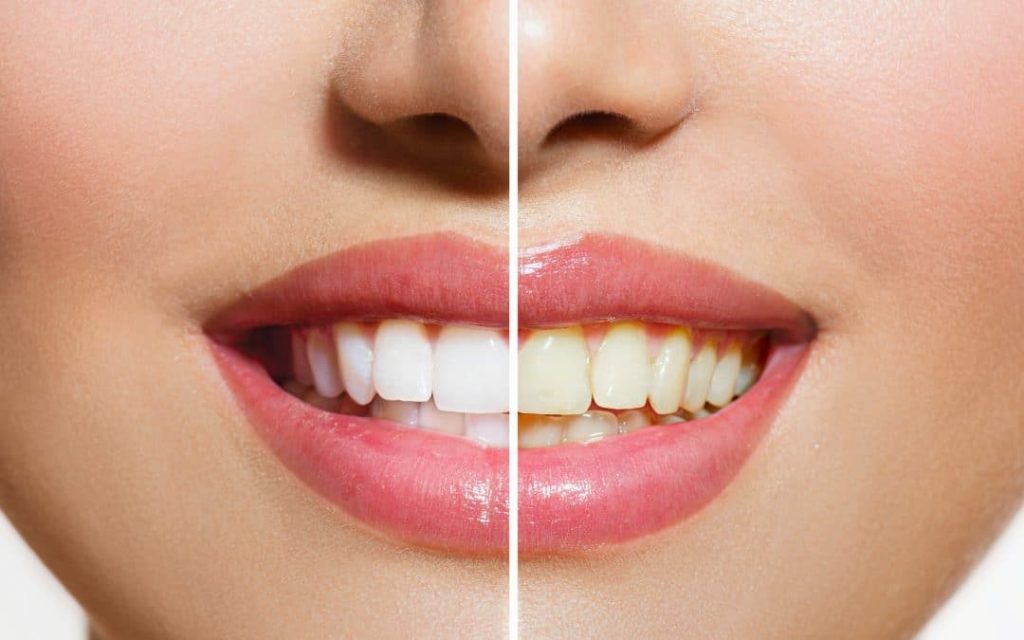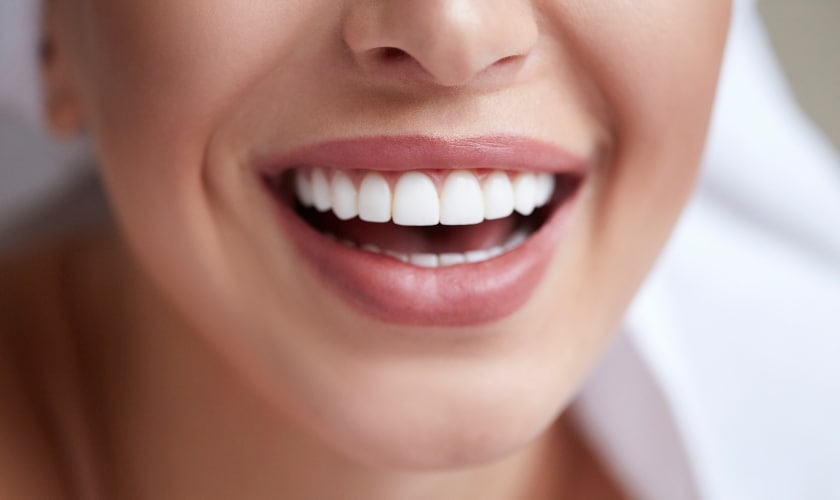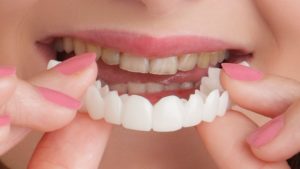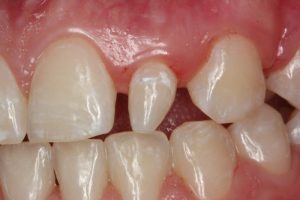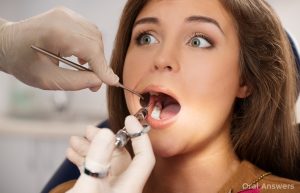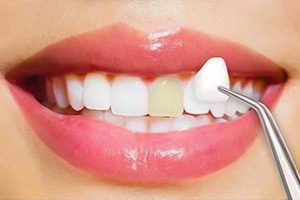I had a little black space near my gums covered with dental bonding a few weeks ago. I love having that space filled because I am self-conscious about it. It looks like my bonding is turning yellow, though. My husband says it’s not, but I swear it’s more yellow than it was when I got it put on. I typically brush with baking soda and that’s not helping. I have a tooth whitening tray from my dentist a year ago. Should I try it on my bonding?
Amelia, Four Corners area
Amelia,
Baking soda is not your best option for dental bonding or porcelain veneers. It is very abrasive and can cause damage to the glaze on the bonding or veneers. The baking soda may be what has made your bonding turn yellow. If the polish has been compromised, that area may be more susceptible to stains from food or drinks, such as berries, coffee, or tea.
The problem could be the bonding material itself. If your dentist wasn’t experienced in cosmetic dentistry, there’s a chance that the materials he used weren’t quality. It may have caused the area to yellow.
How do I fix my yellowed bonding?
As you said you had this bonding done a few weeks ago, you should return to your dentist and ask about the coloration of your bonding. Ask if they can repolish that area. Unfortunately, as with porcelain veneers, no whitening will work. Actually, with bonding, whitening can make that area look worse because it will whiten the tooth around the bonding and leave the bonded area the color it is.
If you can resolve the coloring issue with your bonding with your dentist, look for a specialty toothpaste designed specifically for bonded areas or porcelain veneers, such as Supersmile toothpaste. If your dentist can’t remedy this, you may need to see another cosmetic dentist. That area may not need to be completely redone but may be corrected with just better materials.
Can You Whiten Composite Bonding?
Many people ask how to whiten composite bonding? Or how to keep composite bonding white?
Well, the answer is simple!
Whitening composite bonding, a tooth-colored resin material commonly used for dental bonding procedures, is a bit different from whitening natural teeth. Composite bonding is not as responsive to traditional tooth whitening bonding because the material does not change color like natural tooth enamel.
However, there are a few considerations for composite bonding whiten teeth:
- Pre-existing Color: Composite bonding materials are shade-matched to your natural teeth during the bonding procedure. If your natural teeth have become stained or discolored, the bonded composite may appear different in color over time. In such cases, professional teeth whitening procedures may help to lighten the overall appearance of your smile, but the change in the bonded area may be limited.
- Replacement or Refinishing: If the composite bonding has become noticeably discolored or stained and professional teeth whitening is not sufficient, your dentist may recommend replacing or refinishing the bonding. This involves removing the old composite material and applying new, color-matched composite to achieve a more uniform and whiter appearance.
- Regular Oral Hygiene: Proper oral hygiene practices, including regular brushing, flossing, and professional dental cleanings, can help prevent surface stains on both natural teeth and composite bonding. Maintaining good oral health contributes to the overall appearance of your smile.
- Avoiding Staining Substances: To prevent discoloration, it’s advisable to avoid or limit the consumption of staining substances such as coffee, tea, red wine, and tobacco, which can affect both natural teeth and composite bonding.
- Consultation with Your Dentist: If you are considering any changes to the appearance of your bonded teeth, it’s essential to consult with your dentist. They can assess the current condition of the bonding, discuss your goals, and recommend appropriate options, whether it involves teeth whitening, bonding replacement, or other cosmetic procedures.
While traditional teeth whitening may have limited effects on composite bonding, maintaining good oral hygiene practices and consulting with your dentist can help address and improve the appearance of bonded teeth.
If you’re interested in teeth bonding and whitening, your dentist can guide you on the most suitable and effective options based on your unique situation.
Is it Easy to Whiten Bonded Teeth?
Whitening bonded teeth can be challenging as the composite bonding material does not respond to traditional teeth whitening methods in the same way natural teeth do.
While professional dental polishing may help address surface stains, the success of the procedure depends on the extent and nature of the discoloration. Replacement of the bonding material may be recommended for more substantial color changes.
Additionally, consulting with a dentist is crucial to determine the most suitable approach based on the specific characteristics of the bonding and the desired outcome.
What is the process of Zoom Whitening on bonded teeth?
The Zoom whitening process involves the application of a hydrogen peroxide-based gel and the activation of the gel with a special light to achieve teeth whitening. However, composite bonding material does not respond to the whitening agents in the same way natural teeth enamel does.
Attempting Zoom whitening on bonded teeth may result in uneven color changes, potentially leaving the bonded areas a different shade than the surrounding natural teeth.
How to Whiten Composite Bonding at Home?
Composite bonding whitening at home can be challenging because the resin material used in bonding doesn’t respond to traditional teeth whitening methods like natural teeth. However, if you’re looking to maintain the brightness of your bonded teeth, you can consider the following tips:
- Maintain Good Oral Hygiene: Regular brushing and flossing help prevent surface stains and maintain the overall appearance of your bonded teeth. Use a non-abrasive toothpaste to avoid damaging the bonding material.
- Limit Staining Substances: Reduce the consumption of staining substances such as coffee, tea, red wine, and tobacco. Minimizing exposure to these items can help prevent further discoloration of both natural teeth and the bonding material.
- Whitening Toothpaste: While traditional whitening agents may not be highly effective on composite bonding, using a whitening toothpaste designed for bonded restorations may help reduce surface stains. Choose a toothpaste recommended by your dentist.
- Avoid Harsh Chemicals: Avoid using harsh chemicals or abrasive materials for cleaning. These can potentially damage the bonding material. Stick to gentle oral care products and techniques.
- Regular Dental Check-ups: Schedule regular dental check-ups to monitor the condition of your composite bonding and address any concerns. Professional cleanings by a dentist or dental hygienist can help remove surface stains.
- Hydrogen Peroxide Rinse (Under Supervision): In some cases, a dentist may recommend a diluted hydrogen peroxide rinse for a short duration to help maintain the brightness of composite bonding. However, this should only be done under professional guidance
How to Remove Stains from Bonded Teeth at Home?
Removing stains from bonded teeth at home can be challenging as the composite bonding material doesn’t respond to traditional teeth whitening methods. However, maintaining good oral hygiene practices, including regular brushing and flossing, can help prevent surface stains.
Using a non-abrasive toothpaste and limiting the consumption of staining substances such as coffee, tea, and tobacco may also contribute to preserving the appearance of bonded teeth.
